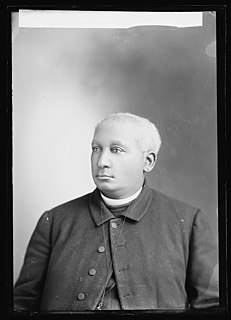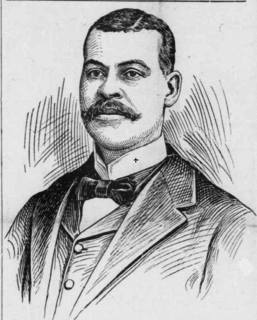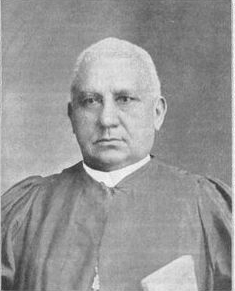
The African Methodist Episcopal Church, usually called the A.M.E. Church or AME, is a predominantly African-American Methodist denomination. It is the first independent Protestant denomination to be founded by black people. It was founded by the Rt. Rev. Richard Allen in Philadelphia, Pennsylvania, in 1816 from several black Methodist congregations in the mid-Atlantic area that wanted independence from white Methodists. It was among the first denominations in the United States to be founded on racial rather than theological distinctions and has persistently advocated for the civil and human rights of African Americans through social improvement, religious autonomy, and political engagement. Allen, a deacon in Methodist Episcopal Church, was consecrated its first bishop in 1816 by a conference of five churches from Philadelphia to Baltimore. The denomination then expanded west and south, particularly after the Civil War. By 1906, the AME had a membership of about 500,000, more than the combined total of the Colored Methodist Episcopal Church in America and the African Methodist Episcopal Zion Church, making it the largest major African-American Methodist denomination.

The Christian Methodist Episcopal (C.M.E.) Church is a historically black denomination within the broader context of Wesleyan Methodism founded and organized by John Wesley in England in 1844 and established in America as the Methodist Episcopal Church in 1784. It is considered to be a mainline denomination. The CME Church was organized on December 16, 1870 in Jackson, Tennessee by 41 former slave members with the full support of their white sponsors in their former Methodist Episcopal Church, South who met to form an organization that would allow them to establish and maintain their own polity. They ordained their own bishops and ministers without their being officially endorsed or appointed by the white-dominated body. They called this fellowship the Colored Methodist Episcopal Church in America, which it remained until their successors adopted the current name in 1954.

The African Methodist Episcopal Zion Church, or the AME Zion Church or AMEZ, is a historically African-American Christian denomination based in the United States. It was officially formed in 1821 in New York City, but operated for a number of years before then.

Benjamin William Arnett was an American educator, minister, bishop and member of the Ohio House of Representatives.
The term Black church refers to the body of Christian congregations and denominations in the United States that minister predominantly to African Americans, as well as their collective traditions and members. The term can also refer to individual congregations.

The Allen Temple AME Church in Cincinnati, Ohio, USA, is the mother church of the Third Episcopal District of the African Methodist Episcopal Church. Founded in 1824, it is the oldest operating black church in Cincinnati and the largest church of the Third Episcopal District of the AME Church.

John A. Lankford was the first professionally licensed African American architect in Virginia in 1922 and in the District of Columbia in 1924. He has been regarded as the "dean of black architecture".

The Big Bethel AME Church is the oldest African-American congregation in the Sweet Auburn neighborhood of Atlanta, Georgia, and according to AME historical documents, it is the mother church of AME in North Georgia. It is located at 220 Auburn Avenue NE in the Sweet Auburn neighborhood. It is the "first" church on the North Atlanta District, in the Atlanta-North Georgia Annual Conference of the African Methodist Episcopal Church.
The Bethel Literary and Historical Society was an organization founded in 1881 by African Methodist Episcopal Church Bishop Daniel Payne and continued at least until 1915. It represented a highly significant development in African-American society in Washington, D.C. Most of its early members were members of the Metropolitan AME Church where its meetings were held, while maintaining an open invitation for black Washingtonians from across the city. It immediately developed into the preeminent debating society and forum for racial issues in Washington, D.C. The prospect of a separation of schools for black children was heatedly debated in 1881–82 as were the ideas of Booker T. Washington and W. E. B. Du Bois in 1903. It was one of the stops of `Abdu'l-Bahá's journeys to the West.

Metropolitan African Methodist Episcopal Church is a historic church located at 1518 M Street, N.W., in downtown Washington, D.C. It affiliates with the African Methodist Episcopal Church.

Henry McNeal Turner was an African-American minister, politician, and the 12th elected and consecrated bishop of the African Methodist Episcopal Church (AME). After the American Civil War, he was a pioneer in Georgia in planting new A.M.E. congregations among African Americans there. Born free in South Carolina, Turner learned to read and write and became a Methodist preacher. He joined the AME Church in St. Louis, Missouri, in 1858, where he became a minister. Founded by free blacks in Philadelphia, Pennsylvania in the early 19th century, the A.M.E. Church was the first independent black denomination in the United States. Later Turner had pastorates in Baltimore, Maryland, and Washington, DC.

The Bethel A.M.E. Church, known in its early years as Indianapolis Station or the Vermont Street Church, is a historic African Methodist Episcopal Church in Indianapolis, Indiana. Organized in 1836, it is the city's oldest African-American congregation. The three-story church on West Vermont Street dates to 1869 and was added to the National Register in 1991. The surrounding neighborhood, once the heart of downtown Indianapolis's African American community, significantly changed with post-World War II urban development that included new hotels, apartments, office space, museums, and the Indiana University–Purdue University at Indianapolis campus. In 2016 the congregation sold their deteriorating church, which will be used in a future commercial development. The congregation built a new worship center at 6417 Zionsville Road in Pike Township, Marion County, Indiana.
Bethel African Methodist Episcopal Church is a church in Morristown, New Jersey.

The Emanuel African Methodist Episcopal Church, often referred to as Mother Emanuel, is a church in Charleston, South Carolina. Founded in 1817, Emanuel AME is the oldest African Methodist Episcopal church in the Southern United States. This first independent black denomination in the United States was founded in 1816 in Philadelphia, Pennsylvania.

Morris Brown was one of the founders of the African Methodist Episcopal Church, and its second presiding bishop. He founded Emanuel AME Church in his native Charleston, South Carolina. It was implicated in the slave uprising planned by Denmark Vesey, also of this church, and after that was suppressed, Brown was imprisoned for nearly a year. He was never convicted of any crime.
John W. Stevenson was an African Methodist Episcopal (AME) Church minister. He was the financier and builder of the Metropolitan African Methodist Episcopal Church in Washington, DC, which was the largest black church in the country at the time of its building. He was a talented fundraiser and built a number of other churches and was pastor of many churches in Maryland, New Jersey, Pennsylvania, New York, and New England. He was an important figure in the church and eventually held the position of presiding Elder of the New York district.

John Mifflin Brown was a bishop in the African Methodist Episcopal (AME) Church. He was a leader in the underground railroad. He helped open a number of churches and schools, including the Payne Institute which became Allen University in Columbia, South Carolina and Paul Quinn College in Waco, Texas. He was also an early principal of Union Seminary which became Wilberforce University.
Abbie K. Mason (1861–1908) was a Black American suffragist. She was known as the president of the Woman's Christian Temperance Union (WCTU) and taught the lessons of Fredrick Douglass at the Memorial African Methodist Episcopal Zion Church of Rochester, New York.

Bishop Singleton T. Jones was a religious leader in the African Methodist Episcopal Zion Church. When he was ten years old, he was apprenticed to a lawyer and worked for him for four years, after which he found positions at an inn, as a hod carrier, and on a riverboat on the Ohio River. He became a pastor in the 1840s, serving churches throughout Pennsylvania, New Jersey, Maryland, and the District of Columbia. Although he had little education, the taught himself to be an articulate orator. Besides being a pastor to churches, he also edited AME Zion publications, the Zion's Standard and Weekly Review and the Discipline.














